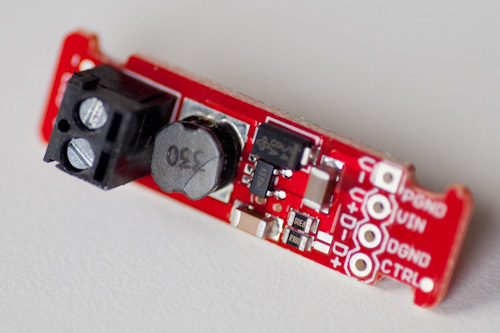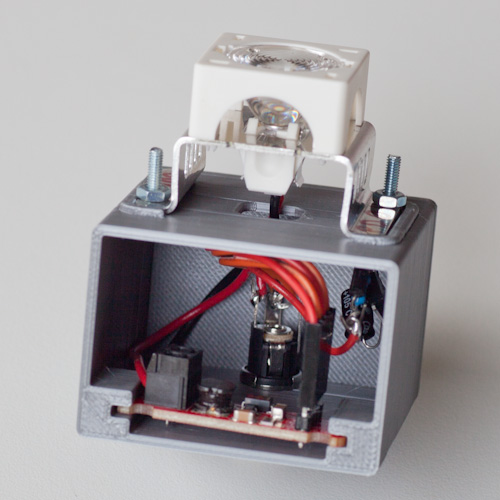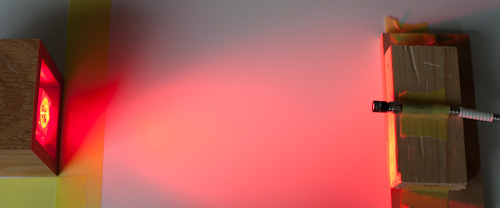LED Color Lamps
September 22, 2019 |
I like colors. The more saturated the better. Many years ago I bought several color power LEDs and had it took me this long to find a way to use them. I have now built seven lamps with power color LEDs. One of each color I have.
The LEDs are from the Luxeon Rebel product line from Lumileds. The colors I have are:
| LED Part number | Color name |
|---|---|
| LXML-PR01-0275 | Royal Blue |
| LXML-PB01-0023 | Blue |
| LXML-PE01-0070 | Cyan |
| LXML-PM01-0090 | Cyan |
| LXM2-PL01-0000 | PC Amber |
| LXML-PH01-0050 | Red Orange |
| LXML-PD01-0040 | Red |
LED Lamps
 |
Each lamp consits of a hollow oak shell with an LED inside. The base is 7cm square and the lamp is 9cm high. All sides have a 2cm wide and 2.5 cm high cutout for connecting the power cable.
The electronics in the lamp are based on the Femtobuck LED driver from Sparkfun. It is a circuit using the AL8805 from Diodes Incorporated. I use it in the default configuration to drive each LED with a constant current of 330mA.
 |
The circuit inside each lamp is basically a Femtobuck board, an LED, and a power connector. I did however break two LEDs due to connecting the power with reversed polarity, so I added a P-channel MOSFET-transistor to prevent that. The circuit did also use twice the amount of current for a short while when connecting the power, so I added an RC-circuit as a slow-start control voltage to the LED driver.
This all resulted in the following schematic:
 |
The insides of the lamp is a 3D-printed encapsulation box, a lens and mounting bracket for the LED, and the LED driver inside. This is what it looks like without the outer shell:
 |
LED Power Spectrum
I have a CCS100 compact specrometer from Thorlabs and have used it to measure the power spectrum of each LED lamp. There are however many sources of errors. The LEDs are several years old and some of them were broken or degraded. This can be from bad handling on my part, or old age. I have also only measured one LED of each kind and my measuring setup is not checked for repeatability. The brightnes of the LEDs wary debending on how I direct the lamp as well.
I measured using the following setup, with the difference that the overhead lights are turned on in the photo below:
 |
I measured the specrum of each LED and got the following result:
Each power spectrum can then be used to calculate the chromacity coordinates for the CIE 1931 2° Standard Observer. I got the following results:
| LED | x | y | Y |
|---|---|---|---|
| Royal Blue | 0.14256 | 0.04260 | 0.01843 |
| Blue | 0.11903 | 0.09906 | 0.07948 |
| Cyan | 0.09233 | 0.64861 | 0.35732 |
| Green | 0.16361 | 0.73121 | 0.35971 |
| PC Amber | 0.56016 | 0.43112 | 0.22856 |
| Red Orange | 0.68856 | 0.30974 | 0.20877 |
| Red | 0.70384 | 0.29254 | 0.07492 |
The Y column gives a general sense of the apparent brightness of each LED. It is however probable that my test setup is not stable enough to compare this between the LEDs. The lens in the lamp has some high-spots witch make it hard to align repeatably.
To get a sense of what the x and y numbers mean, I have put them in the xy chromacity diagram:
I put the sRGB gamut triangle in the diagram as a reference. It makes it easier for me to get a sense of how the colors compare to a computer screen or a regular RGB LED.
I like the results of this project. The lamps look good and I can now reference various colors more easily. The LEDs are hard to power and the Femtobuck made that easy. I also have more experience with building things of wood and with 3D-printing. The spectrum measurements are also good to have as it gives me a good idea of what I can expect of future projects with power color LEDs.